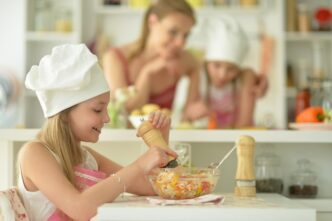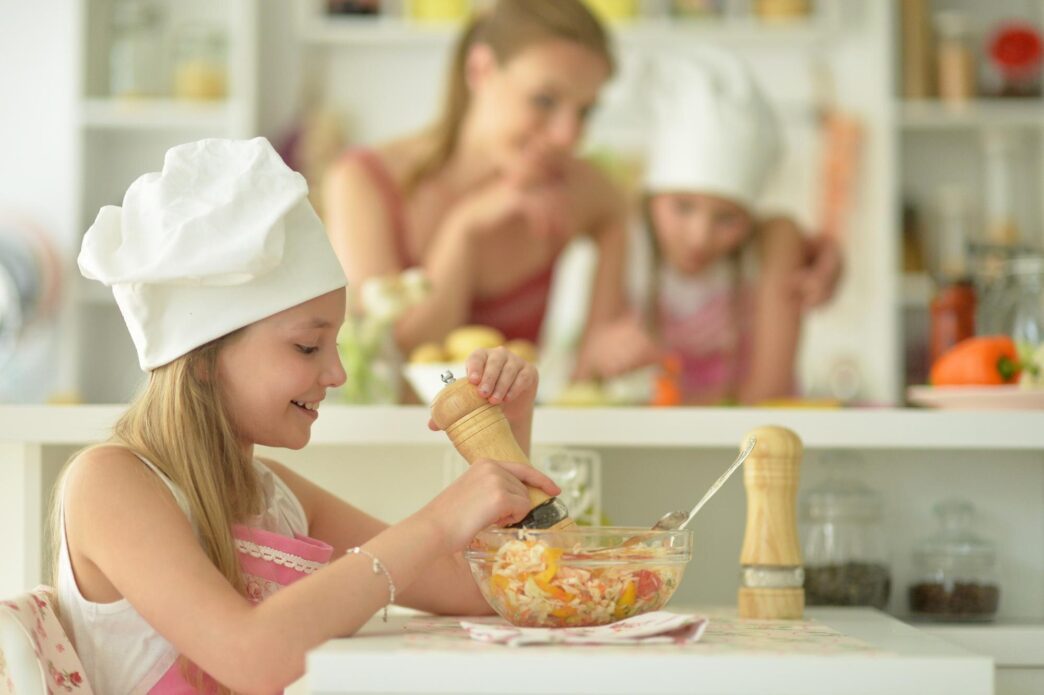A Quick Takeaway
The Story Behind the Trend
How to Make It Work for You
The Community View
Involving children in the process of preparing healthy meals is a powerful way for families to cultivate lifelong healthy eating habits, develop essential life skills, and strengthen bonds, transforming an everyday chore into an engaging and educational activity. This approach, which encourages kids to become active participants in the kitchen, not only demystifies food preparation but also empowers them to make nutritious choices, fostering a deeper connection to the food they eat and the people they share it with.
Why Cooking with Kids Matters
Engaging children in the kitchen offers a myriad of benefits that extend far beyond simply getting dinner on the table. It provides a hands-on learning environment where kids can absorb practical skills while also developing a positive relationship with food.
One of the primary advantages is the promotion of healthier eating habits. Children are often more willing to try foods they have helped prepare, even those they might typically shun. This direct involvement makes them feel invested in the meal, increasing their curiosity and openness to new flavors and textures.
Cooking also serves as an invaluable educational tool, integrating lessons in math, science, and reading. Measuring ingredients teaches fractions, observing ingredients change under heat introduces basic chemistry, and following a recipe enhances literacy and comprehension skills. These practical applications make learning tangible and exciting.
Furthermore, culinary activities boost children’s confidence and independence. Mastering a new skill, like cracking an egg or chopping vegetables safely, instills a sense of accomplishment and self-reliance. This empowerment translates into other areas of their lives, encouraging them to tackle new challenges.
Finally, cooking together creates cherished family memories and strengthens communication. The kitchen becomes a space for shared laughter, stories, and teamwork, fostering deeper connections and a sense of belonging within the family unit.
Setting the Stage for Success
To ensure a positive and productive experience, a little preparation goes a long way. Creating a safe, fun, and age-appropriate environment is crucial for unleashing your kids’ inner chefs.
Prioritize safety by teaching essential kitchen rules, such as washing hands, handling knives properly (or using child-safe alternatives), and understanding heat sources. Always supervise younger children closely, and ensure they have a sturdy step stool to reach the counter comfortably.
Manage expectations by embracing the fact that cooking with kids can be messy and might take longer than cooking alone. The goal is the process and the learning, not necessarily a perfectly executed dish. View spills and crumbs as part of the adventure, not a failure.
Make it an enjoyable experience by allowing children to choose recipes or ingredients from a pre-selected list. When kids have a say in what they’re making, their enthusiasm and engagement naturally increase. Play music, tell stories, and focus on the fun aspects of creation.
Age-Appropriate Kitchen Tasks
Tailoring tasks to a child’s developmental stage is key to keeping them engaged and safe. Start with simple activities and gradually introduce more complex ones as their skills and confidence grow.
Toddlers (Ages 2-3)
Even the youngest chefs can participate in basic, low-risk activities. They can wash fruits and vegetables in a bowl of water, stir ingredients in a bowl, tear lettuce for salads, or sprinkle herbs. These tasks develop fine motor skills and introduce them to different textures and smells.
Preschoolers (Ages 4-5)
Preschoolers can handle slightly more intricate tasks with supervision. They can measure and pour ingredients, mash soft foods like bananas or avocados, and use child-safe knives for soft items like cucumbers or cheese. Rolling dough or kneading bread are also great activities for this age.
Early Elementary (Ages 6-8)
Children in early elementary school are ready for tasks that require more focus and coordination. They can read simple recipes, crack eggs, use a vegetable peeler, and learn basic chopping techniques with supervision. This is a good age to introduce them to using graters and mixing ingredients by hand.
Pre-Teens and Teens (Ages 9+)
Older children can take on significant responsibility, often preparing entire dishes with minimal supervision. They can follow complex recipes, operate stovetop burners and ovens safely, and even contribute to meal planning and grocery shopping. Encourage them to experiment with flavors and adapt recipes to their taste.
Family-Friendly Recipe Ideas
Start with simple, versatile recipes that offer many opportunities for participation. Meals that allow for customization are particularly engaging, as they give children a sense of ownership over their creations.
Smoothies and fruit salads are excellent starting points, allowing kids to choose ingredients, wash produce, and operate blenders (with supervision). Homemade pizzas are another fantastic option, where children can roll dough, spread sauce, and arrange toppings.
Healthy baked goods, such as whole-wheat muffins or energy balls, teach measuring and mixing. Taco nights or stir-fries are perfect for involving kids in chopping vegetables, assembling components, and learning about different cultural flavors. Even something as simple as making sandwiches or wraps can be a fun and healthy family activity.
Tips for a Positive Culinary Journey
Cultivating a positive cooking environment is essential for long-term engagement. Patience, encouragement, and a focus on the shared experience will make cooking a joyful family tradition.
Always start small, perhaps with one new task or ingredient at a time, to avoid overwhelming your child. Be patient and positive, offering gentle guidance rather than criticism. Remember that mistakes are part of the learning process.
Let your children choose recipes or ingredients when possible, fostering their enthusiasm. Embrace the mess as a sign of active participation, knowing that cleanup is also a shared responsibility. Most importantly, celebrate their efforts and creations, regardless of the outcome. Acknowledge their hard work and the joy of cooking together.
Beyond the Kitchen
The journey of food exploration doesn’t have to end in the kitchen. Extend the learning by involving children in other food-related activities. Planting a small herb garden or a few vegetables teaches them about where food comes from and the effort involved in growing it.
Visiting local farmers’ markets allows children to interact with growers, learn about seasonal produce, and make informed choices about fresh ingredients. Involving them in meal planning and grocery list creation also reinforces healthy choices and budgeting skills.
Nurturing Young Palates
Inviting children into the kitchen is one of the most effective ways to nurture healthy eating habits, develop crucial life skills, and create lasting family memories. By providing age-appropriate tasks, fostering a supportive environment, and embracing the process, families can transform meal preparation into an enriching and enjoyable adventure. This investment in their culinary education empowers children to become confident, adventurous eaters and contributes to a healthier, happier family life.







